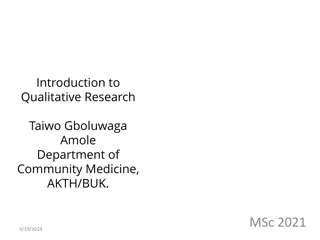Qualitative vs. Quantitative Approaches in Health Research
Exploring the different methodologies, paradigms, and methods used in health research, this content highlights the distinction between qualitative and quantitative designs. It covers research questions, aims, objectives, hypotheses, and various quantitative approaches such as experimental and observational studies. Additionally, it delves into the concept of paradigms, methodology, and the methods used for data collection and analysis in research activities. A case study on measuring readiness and motivation to quit smoking among women in public health clinics is also presented.
Download Presentation

Please find below an Image/Link to download the presentation.
The content on the website is provided AS IS for your information and personal use only. It may not be sold, licensed, or shared on other websites without obtaining consent from the author.If you encounter any issues during the download, it is possible that the publisher has removed the file from their server.
You are allowed to download the files provided on this website for personal or commercial use, subject to the condition that they are used lawfully. All files are the property of their respective owners.
The content on the website is provided AS IS for your information and personal use only. It may not be sold, licensed, or shared on other websites without obtaining consent from the author.
E N D
Presentation Transcript
Day 4: Qualitative Designs Sioape Kupu Health Research Officer
Recap Research Questions? Research Aim Research Objective Research Hypothesis
Recap Quantitative Approaches Exploratory Descriptive Studies Explanatory 1) Experimental Studies Two Group Post-test Comparison Two Group Pre-test Post-test Comparison Solomon Four Group Test 2) Observational Studies Cohort/Longitudinal Studies Case-Control Cross-Sectional (Prevalence)
Paradigm There are many different Paradigms Complex
Methodology The strategy, plan of action, process or design lying behind the choice and use of particular methods and linking the choice and use of methods to the desired outcomes. -Crotty(1997) Many different methodologies *Experimental *Observational Longitudinal *Survey *Case-Control *Cross- Sectional etc.
Methods Techniques and procedures used to gather and analyze data related to some research question or hypothesis. Examples: Questionnaire Observation: Participant, Non-participant Sampling Measurement and Scaling Interview Focus Group Case-Study RCT
Activity Revisited 1) What is the aim of this research? 2) What relationship is the article trying to find out? (exposure outcome) 3) Who are the population of interest? 4) What sort of methodologyis being used? 5) What epistemologywould you expect for this type of study?
Crittenden, K.S., Manfredi, C., Lacey, L., Warnecke, R., Parsons, J. (1994) Measuring readiness and motivation to quit smoking among women in public health clinics.Addictive Behaviors 19(5):497-507 Abstract 1: We conducted a pilot test of an instrument to assess stage of readiness and level of motivation to change smoking behaviour among 495 women smokers in public health clinics. We found that 8% of the total sample planned no change in smoking ever; 8% were seriously thinking of cutting down; and 25% were seriously thinking of quitting but not within 6 months. Scales in the questionnaire included general motivation to change smoking behaviour and confidence in one's ability to do so. Pregnancy enhanced readiness to quit. The instrument accommodates the brevity and low literacy requirements for use in these applied settings and is suitable for use in either self-administered questionnaire orinterview format.
(Beasleyet al., 1981). Abstract 2: A study of 22 707 Chinese men in Taiwan was set up to investigate the association between the hepatitis B surface antigen (HBsAg) and the development of primary hepatocellular carcinoma. The study was conducted among male government employees who were enrolled through routine health care services. All participants completed a health questionnaire and provided a blood sample at the time of their entry into the study. Participants werethenfollowed up foran averageof 3.3 years
(Buringet al.,1986). Abstract 3: The study attempts to identify the relationship between use of conjugated estrogens and the risk of endometrial cancer was examined among 188 white women aged 40 80 years with newly diagnosed endometrial cancer and 428 controls of similar age hospitalized for non-malignant conditions requiring surgery at the Boston Hospital for Women Parkway Division, Massachusetts, between January 1970 and June 1975. The data on drug use and reproductive variables were extracted from hospital charts and from the medical records of each woman s private physician. Thirty-nine per cent of the cases and 20% of the controls had used conjugated estrogens in the past.
(Muoz et al., 1992a). Abstract 4: A population-based study was carried out in Spain and Colombia to assess the relationship between cervical cancer and exposure to human papillomavirus (HPV), selected aspects of sexual and reproductive behaviour, use of oral contraceptives, screening practices, smoking, and possible interactions between them. The study included 436 incident cases of histologically confirmed invasive squamous-cell carcinoma of the cervix and 387 controls of similar age randomly selected from the general population that generated the cases.
(Bobak,Skodova & Marmot (2003). Beer and obesity) Abstract 5: There is a common notion that beer drinkers are, on average, more 'obese' than either nondrinkers or drinkers of wine or spirits. This is reflected, forexample, by the expression 'beer belly'. However, the few studies on the association between consumption of beer and abdominal obesity produced inconsistent results. We examined the relation between beer intake and waist-hip ratio (WHR) and body mass index (BMI) in a beer-drinking general population of six districts of the Czech Republic. A random sample of 1141 men and 1212 women aged 25-64 y (response rate 76%) completed a questionnaire and underwent a short examination in a clinic. Intake of beer, wine and spirits during a typical week, frequency of drinking, and a number of other factors were measured by a questionnaire. Beer intake was not related to BMI in men. In women, beer intake was not related to WHR, but there was a weak inverse association with BMI. It is unlikely that beer intake is associated with a largely increasedWHRorBMI.
(Pacific Islands Families Study, Faculty of Health and Environmental Sciences, AUT University, Auckland, New Zealand.). Abstract 6: The Pacific Islands Families (PIF) study is a longitudinal investigation of a cohort (N=1376) of Pacific infants born in New Zealand (NZ), and their mothers and fathers. The PIF study aimed to determine: (1) the prevalence of disciplinary and nurturing parenting practices used with children at 12 months of age, and (2) the demographic, maternal and lifestyle factors associated with parenting practices. mothers (N=1207) were interviewed about their parenting practices using a modified version of the Parent Behavior Checklist.. At the unilabiate level, high discipline scores were significantly associated with gambling, postnatal depression and lack of alignment to either Pacific or to European traditions. However the strongest association with discipline was the ethnicity variable with Tongan mothers reporting significantly higher disciplinary behaviors than all otherethnicities. At the 12-month measurement point,
Day 4 Objectives 1. To understand the four different Qualitative Methodologies; Case Study Ethnography Phenomenology Grounded Theory 2. To differentiate between the Qualitative Methodologies; 3. To differentiate between Quantitative and Qualitative; 4. Have a basic understanding of Mixed Methods;
Qualitative Designs Most Qualitative Studies adopt a Non-Positivist Approach. Four Main Designs or Approaches Case Study Ethnography Phenomenology Grounded Theory
Case Study Can actually be qualitative or quantitative Single or small number of sampling units or participants Vary in complexity Offers richness and depth of information The .case(s). may not be representative of the population and therefore not generalizable, BUT that should not be the purpose of a case study design
Ethnography (Portrait of people) Comes from anthropology Descriptive study of cultures and peoples Often used in health where a .culture. is suspected of influencing a population's response to care or treatment Often involves formal and informal interviews, participant observation, etc. Is very time-consuming Data is analyzed from the point of view of the population under study Is difficult when the researcher is unfamiliar with the population
Phenomenology (Study of phenomena) Often used to describe all qualitative research, but also used to describe a particular methodology A way of describing something in our world Helps us to understand phenomena that have not been overtly or adequately described and explained Will not necessarily provide definitive explanations but will raise awareness and increase insight into a phenomena Often involves interviews and focus groups
Grounded Theory Development of a new theory through the collection and analysis of data about a phenomenon (Induction in Nature). More than just descriptive, so go beyond the scope of phenomenology. Often uses interviews, lit reviews, documentary analysis, etc Simultaneous collection and analysis, using .constant comparative analysis. New ideas are then integrated in the subsequent data collection New theories emerge from the new ideas and themes observed in the data, so the theory is .grounded. in the data
Qualitative Data Collection Methods Interviews Focus groups Participant observations Documentary analysis Video/photos/art etc. Etc.
Benefits of Qualitative Research Usually less resource intensive No better way than qualitative research to understand in-depth the attitudes, motivations and feelings of people Qualitative research can improve the efficiency and effectiveness of quantitative research
Limitations of Qualitative Research Qualitative research doesn t distinguish small differences between groups as well as quantitative research can. Not representative of the population that is of interest to the researcher The large number of qualitative researchers who have no formal training but profess to be experts in the field!
Quantitative and Qualitative Qualitative Quantitative Nature Non-numerical (Subjective) Numerical (Objective) Structure Flexible Very Structured Type of Questions Probing Limited Probing SampleSize Small Large Information Per Respondent Rich Varies Administration Requires Skilled Researchers Fewer SpecialistSkills Required Type of Analysis Subjective, Interpretative. Statistical Type of Research Exploratory Descriptiveor Explanatory
Braithwaite, R.L., Bianchi, C., Taylor, S.E. (1994) Ethnographic Approach to Community Organization and Health Empowerment. Health Educ Behav 21(3):407-416 The purpose of this article is to address pertinent issues relative to the association between community organization and health empowerment methods in ethnic communities of colour. It seeks to address these issues by utilizing ethnographic procedures for documenting community health concerns and by advocating for empowerment for people of colour and their participation in coalition partnerships. Increasingly the importance of citizen participation in the planning, assessment, and implementation of community-based health initiatives has been identified as essential for effective health promotion and disease prevention programs. This article argues for the utility of a community organization approach for achieving health empowerment, and subsequently decreasing the excess deaths in communities of colour. The interface of ethnographic procedures, community organization, and development of community- owned action plans for programming health interventions is discussed.
Mixed Methods Research Best of both worlds? Uses both Quantitative and Qualitative Methods. Triangulation as a form of Analysis A popular approach for health services research and evaluation Quantitative tells us if it works, or not Qualitative tells us why Usually in two phases : First Phase Quantitative then Second Phase: Qualitative. Different from multi-methods which are two methodologies from the same principle (1stPhase Quantitative 2ndPhase Quantitative)
Day 4 Objectives 1. To understand the four different Qualitative Methodologies; Case Study Ethnography Phenomenology Grounded Theory 2. To differentiate between the Qualitative Methodologies; 3. To differentiate between Quantitative and Qualitative; 4. Have a basic understanding of Mixed Methods;
Reading List Liamputtong, P & EzzyD. (2005) Qualitative Research Methods: Second Edition. Oxford University Press: Victoria Australia. Thank You!























